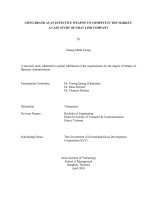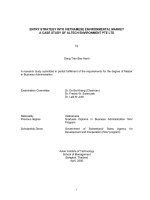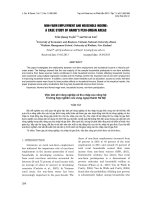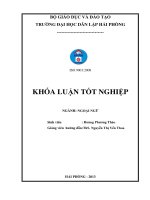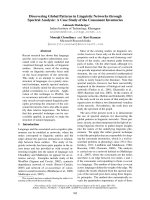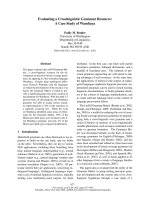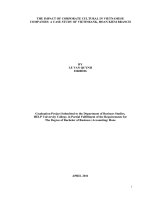samr model’s modification a case study of efl teachers’ perception about the learning usefulness of ict integration
Bạn đang xem bản rút gọn của tài liệu. Xem và tải ngay bản đầy đủ của tài liệu tại đây (2.48 MB, 132 trang )
MINISTRY OF EDUCATION AND TRAINING
HO CHI MINH CITY OPEN UNIVERSITY
SAMR MODEL’S MODIFICATION: A CASE STUDY OF EFL
TEACHERS’ PERCEPTION ABOUT THE LEARNING
USEFULNESS OF ICT INTEGRATION
A thesis submitted in partial fulfillment of the requirements for the
degree of
Master of Arts (TESOL)
Submitted by NGUYEN XUAN MINH
Supervisor: LE HOANG DUNG, Ph.D.
Ho Chi Minh City, September 2019
MINISTRY OF EDUCATION AND TRAINING
HO CHI MINH CITY OPEN UNIVERSITY
NGUYEN XUAN MINH
SAMR MODEL’S MODIFICATION: A CASE STUDY OF EFL
TEACHERS’ PERCEPTION ABOUT THE LEARNING
USEFULNESS OF ICT INTEGRATION
Major: TEACHING ENGLISH TO SPEAKERS OF OTHER LANGUAGES
Major code : 60140111
MASTER OF ARTS IN TESOL
Supervisor: Dr. LE HOANG DUNG
Ho Chi Minh City, September 2019
i
STATEMENT OF AUTHORSHIP
I certify that this thesis entitled “SAMR Model’s Modification: A Case Study of
EFL Teachers’ Perception about Learning Usefulness of ICT Integration” is my own
work.
Except where reference is made in the text of the thesis, this thesis contains material
published elsewhere or extracted in whole or in part from publications of which I am the
only author.
No other person’s work has been used without due acknowledgement in the main
text of the thesis.
This thesis has not been submitted for the award of any degree or diploma in any
other tertiary institutions.
Ho Chi Minh City, September 2019
NGUYEN XUAN MINH
ii
RETENTION AND USE OF THE THESIS
I hereby state that I, Nguyen Xuan Minh, being a candidate for the degree of
Master of Arts in TESOL, accept the requirements of Ho Chi Minh City Open University
relating to the retention and use of Master’s Theses deposited in the Library.
In terms of these conditions, I agree that the original of my Master’s Thesis
deposited in the Library should be accessible for the purposes of study and research, in
accordance with the normal conditions established by the Librarian for the care, loan, and
reproduction for theses.
Ho Chi Minh City, September, 2019
NGUYEN XUAN MINH
iii
ACKNOWLEDGEMENTS
The journey I have taken in my Master’s education for TESOL has consummated in
the completion of this thesis. I have come this far in the quest for knowledge and academic
achievements thanks to the immense support of people I am more than happy to be around.
I would love to send my deep gratitude to my mother who has always been with me
since the start of my learning at Ho Chi Minh City Open University. Also, I would like to
say big thanks to my friends who teaches for EFTIN project and enthusiastically helped
me complete the survey and interviews. Without their help, I would not have been able to
have the thesis done this well. Especially, it is my honor to express my gratefulness to my
supervisor, Dr. Le Hoang Dung, for being so supportive, patient, and encouraging to me
during the time I managed to find a proper approach to my thesis topic. He always had
useful leading questions in our meetings amid hectic working weeks, and his questions
definitely lit up many corners of my misunderstanding in research and helped me figure
out the appropriate approach to tackle my research problems.
In general, I am happy to consider this Master’s thesis as a puzzle I could solve
thanks to the pieces I was given from my beloved family, friends, and teacher.
iv
TABLE OF CONTENTS
STATEMENT OF AUTHORSHIP ............................................................................................................ i
RETENTION AND USE OF THE THESIS ............................................................................................. ii
ACKNOWLEDGEMENTS ...................................................................................................................... iii
TABLE OF CONTENTS .......................................................................................................................... iv
LIST OF ABBREVIATIONS ................................................................................................................... vi
LIST OF TABLES .................................................................................................................................... vii
LIST OF APPENDICES ............................................................................................................................ x
Abstract ........................................................................................................................................................ xi
CHAPTER 1: INTRODUCTION .............................................................................................................. 1
1.1.
Vietnamese context of ICT use in education ............................................................................... 1
1.2.
The measurement of levels of ICT integration with different frameworks ................................. 3
1.3.
Statement of the problem............................................................................................................. 4
1.4.
Aims of the study......................................................................................................................... 6
1.5.
Research questions ...................................................................................................................... 6
1.6.
Significance of the study ............................................................................................................. 7
1.7.
Definitions of key terms .............................................................................................................. 7
1.8.
Organization of the study ............................................................................................................ 8
CHAPTER 2: LITERATURE REVIEW ................................................................................................ 10
2.1.
SAMR model ............................................................................................................................. 10
2.2.
The inconsistency in the interpretation of the levels in SAMR model ...................................... 12
2.3.
ICT integration for EFL learning support .................................................................................. 16
2.4.
Hypothesis ................................................................................................................................. 24
CHAPTER 3: METHODOLOGY ........................................................................................................... 26
3.1.
Research design ......................................................................................................................... 26
3.2.
Participants ................................................................................................................................ 26
3.3.
Research tools ............................................................................................................................ 27
3.3.1.
The survey ............................................................................................................................. 28
3.3.2.
The interview ........................................................................................................................ 30
3.4.
Data collection and analysis procedure ..................................................................................... 31
3.5.
Validity and reliability ............................................................................................................... 33
3.6.
Ethical issues ............................................................................................................................. 35
CHAPTER 4: FINDINGS OF THE STUDY .......................................................................................... 37
4.1.
The priorities of EFL teachers for learning supporting effects of their ICT integration ........... 37
v
4.1.1. The survey results ..................................................................................................................... 37
4.1.2. Analysis of interview responses ................................................................................................ 40
4.2. The learning usefulness of seven effects of ICT integration. ........................................................... 48
4.2.1.
effect
The correlation between the learning usefulness of each effect and of the situation having that
49
4.2.2. Findings from the interviews about the perceived learning usefulness of effects of ICT
integration ........................................................................................................................................... 59
4.2.3. The ranking of EFL teachers’ perceived learning usefulness of seven effects of ICT
integration ........................................................................................................................................... 65
CHAPTER 5: DISCUSSION OF THE RESULTS ................................................................................ 69
5.1.
EFL teachers’ prioritized learning supporting effects of ICT integration ................................. 69
5.1.1.
Prioritity for effects 6, 5, 3 and 4 .......................................................................................... 69
5.1.2.
Priority for effects 1, 7, and 2................................................................................................ 70
5.2.
The correlation between EFL teachers’ perceived learning usefulness of ICT effects and that of
the situation having the effects................................................................................................................ 72
CHAPTER 6: CONCLUSION OF THE STUDY .................................................................................. 77
6.1.
The summary of key findings of the study ................................................................................ 77
6.2.
Implications of the study ........................................................................................................... 78
6.3.
Limitations of the study ............................................................................................................. 79
6.4.
Recommendations for further studies ........................................................................................ 80
6.5.
Conclusions ............................................................................................................................... 80
References .................................................................................................................................................. 82
APPENDICES ........................................................................................................................................... 88
APPENDIX 1: THE SURVEY ................................................................................................................. 89
APPENDIX 2: THE INTERVIEW ....................................................................................................... 106
APPENDIX 3: DEMOGRAPHICS OF THE PARTICIPANTS ........................................................ 110
APPENDIX 4: RESULTS OF RELIABILITY TESTS OF THE SURVEY ..................................... 112
APPENDIX 5: LETTER TO PARTICIPANTS AND CONSENT FORM........................................ 117
CONSENT FORM .................................................................................................................................. 119
vi
LIST OF ABBREVIATIONS
BECTA
British Educational Communications and Technology Agency
EFL
English as a Foreign Language
EFTIN
English for those in need (name of an online teaching group)
ICT
Information Communication Technology
NFLP 2020 National Foreign Language 2020 Project
vii
LIST OF TABLES
Table 2. 1 ...................................................................................................................................... 12
Table 3. 1 ICT tools used in the survey questions ........................................................................ 29
Table 3. 2 Details of invalid items in the survey .......................................................................... 33
Table 3. 3 Cronbach’s Alpha scores of the 7 effects after the removal of invalid items. ............. 34
Table 3. 4 The summary of the survey before the removal of invalid items ................................ 34
Table 3. 5 The summary of the survey after the removal of invalid items ................................... 35
Table 4.1 Percentages of teachers’ priority for ICT integration ................................................... 38
Table 4. 2 Comparison of Mean values of prioritized effects of ICT integration that support
learning ......................................................................................................................................... 39
Table 4. 3 EFL teachers’ priority for learning supporting effects of ICT integration................... 40
Table 4. 4 The comparison between the perceived learning usefulness of effect 1 and that of the
situations having the effect ........................................................................................................... 49
Table 4. 5 The correlation between perceived learning usefulness of effect 1 and that of the
situations having the effect ........................................................................................................... 50
Table 4. 6 The comparison between the perceived learning usefulness of effect 2 and that of the
situations having the effect ........................................................................................................... 51
Table 4. 7 The correlation between perceived learning usefulness of effect 1 and that of the
situations having the effect ........................................................................................................... 51
Table 4. 8 The comparison between the perceived learning usefulness of effect 3 and that of the
situations having the effect ........................................................................................................... 52
viii
Table 4. 9 The correlation between perceived learning usefulness of effect 3 and that of the
situations having the effect ........................................................................................................... 53
Table 4. 10 The comparison between the perceived learning usefulness of effect 4 and that of
the situations having the effect ..................................................................................................... 54
Table 4. 11 The correlation between perceived learning usefulness of effect 4 and that of the
situations having the effect. .......................................................................................................... 54
Table 4. 12 The comparison between the perceived learning usefulness of effect 5 and that for
the situations having the effect ..................................................................................................... 55
Table 4. 13 The correlation between perceived learning usefulness of effect 5 and that of the
situations having the effect. .......................................................................................................... 55
Table 4. 14 The comparison between the perceived learning usefulness of effect 6 and that of the
situations having the effect ........................................................................................................... 56
Table 4. 15 The correlation between perceived learning usefulness of effect 6 and that of the
situations having the effect ........................................................................................................... 56
Table 4. 16 The comparison between the perceived learning usefulness of effect 7 and that for
the situations having the effect ..................................................................................................... 57
Table 4. 17 The correlation between perceived learning usefulness of effect 7 and that of the
situations having the effect ........................................................................................................... 58
Table 4. 18 Correlation between EFL teachers’ perceived learning usefulness of each effect and
of situations having that effect ...................................................................................................... 59
Table 4. 19 Mean values of perceived usefulness of effects from largest to smallest and those of
situations having the effects .......................................................................................................... 65
Table 5. 1 The use of the modified SAMR model in solving the inconsistency of the old model73
ix
LIST OF FIGURES
Figure 2.1: SAMR model (Puentedura, 2006) ...............................................................................11
Figure 3. 1 A summary of the research instruments
28
Figure 3. 2 Data collection and analysis
31
Figure 4. 1 The suggested modification of two Transformation levels of SAMR model
67
x
LIST OF APPENDICES
APPENDIX 1: THE SURVEY ................................................................................................... 89
APPENDIX 2: THE INTERVIEW ......................................................................................... 106
APPENDIX 3: DEMOGRAPHICS OF THE PARTICIPANTS ............................................110
APPENDIX 4: RESULTS OF RELIABILITY TESTS OF THE SURVEY .........................112
APPENDIX 5: LETTER TO PARTICIPANTS AND CONSENT FORM ...........................117
xi
Abstract
The use of information communication technology (ICT) at high levels to enhance
learning is intriguing to many teachers in this modern age of education. A case study was
conducted with 18 out of 25 EFL teachers involved in a project of online teaching called
English For Those In Need (EFTIN). The study used online surveys and in-depth
interviews to find out (1) the belief of these EFL teachers in terms of their prioritized
effects of ICT integration for improving learning, and (2) their perceived learning
usefulness of ICT integration in alignment with the transformation degree including
Modification and Redefinition levels of SAMR model (Puentedura, 2006). The study
found that for EFL teachers, their ICT integration is prioritized the most for 4 effects: (1)
creating motivation, (2) stimulating collaborative learning, (3) creating conditions for
learning with authentic language, and (4) integrating different language skills, while such
effects as (5) providing convenience of space and time for learning, and (6) creating
games for lessons together ranked fifth, and (7) facilitating student’s learning by the
creation of artifacts ranked seventh on the scale of priority. However, the results of EFL
teachers’ perceived learning usefulness of those seven effects in specific situations of
technology use showed very different ranking. The study results suggested a detailed
description for the two levels of ICT integration of SAMR model: Modification and
Redefinition with four effects sorted to the Redefinition level and the other three effects
to Modification level.
Keywords: ICT integration levels, teacher’s priority in ICT integration, learning
usefulness of ICT integration, SAMR model
SAMR MODEL: A MODIFICATION BASED ON EFL TEACHERS’ PERCEPTION
1
CHAPTER 1: INTRODUCTION
This chapter presents the Vietnamese background to the study. Then it detailes the
frameworks for measuring ICT integration. Subsequently come the statement of problem,
aims of the research, the research questions, the significance of the study, definition of
key terms, and the organization of the study.
1.1.
Vietnamese context of ICT use in education
For a better understanding of the study, it is essential to describe its context.
Vietnam is a country thirsty for innovative technology, with the vigorous expansion of the
technology market in the recent decade to be one of the “Power 4 of Asia” in the
development of smart phones, and 43.9% of the population use the Internet (Wan, 2015).
The access to desktop computers, laptops, and smart phones is not a fancy idea but within
reach for many students, especially in cities. Furthermore, Vietnam’s National Foreign
Language Project 2020 (NFLP2020) has helped equip schools in the whole country with
computer laboratories for teaching and learning languages. Additionally, computing is
now taught as a compulsory subject for students at secondary and high schools. A large
number of students are even sent to short courses of computing in training centers where
they study Microsoft words, excel, excess, and Pascal among many other programs to get
computing certificates in preparation for future studies and jobs. In big cities, there are
even attempts to issue electronic student numbers at secondary and high schools which
allow them to build their student online profiles, and check their grades online. In short,
the facilities and skills are expected to be adequate for Vietnamese students to get
involved in learning with ICT tools.
On the macro national scale, Vietnam’s National Foreign Language 2020 Project
started in 2008 with the resolution 1400/QĐ-TTg issued by the Prime Minister on 30
September 2008 naming seven objectives, in which the final one emphasizes the use of
ICTs in teaching and learning foreign languages (NFLP2020, 2008). From the national
project, a user’s guide for Competencies Framework for English Language Teachers,
SAMR MODEL: A MODIFICATION BASED ON EFL TEACHERS’ PERCEPTION
2
commonly mentioned as ETCF, is constructed to describe the required competencies of
English teachers one of which is competency 2.6 detailing the capability of teachers to
use basic ICT tools in teaching and to teach their students how to use these tools for
learning (NFL2020, MOET, & VNIES, 2012). To realize that goal, courses of technology
in education are organized in various schools by educational centers and large
universities in Vietnam to prepare teachers teaching English as a Foreign Language
(EFL) for integrating technology into their lesson delivery. In that movement, technology
has woven its way into schools and become an integral part of Vietnamese nationwide
teaching practice.
As regards technology support, on the website of NFL2020P, a bountiful
collection of articles about how to integrate ICT into teaching have been recommended.
Besides the website of Vietnam’s NFL2020P, a technology hub was also created by the
Ministry of Education and Training (MOET) at to provide a
variety of educational tools such as Moodle, Lecture Maker, and Adobe Presenter 7, and
other software and applications for video and audio editing or presentation, together with
advice to use such tools for designing teaching materials. Moreover, the online library
is also one of the most visited websites for teachers of all subjects to
exchange lesson plans, tests, and exercise collections. Recently, a six-free-course
program of educational technology has officially been recommended on the website of
the National Foreign Language 2020 Project. It is offered on
by the educational network of Microsoft which has
attracted millions of educators worldwide. The course gives opportunities for teachers to
upgrade their knowledge and skills in using updated educational technologies at a very
modest cost of an internet connection. A Facebook closed group of ICT practitioners MIE Expert Vietnam (Microsoft Innovative Educator) also functions like a community of
practice where new ways of integrating ICT in the classroom are shared, achievements
celebrated, contributions acknowledged, and questions raised for consultations. This
online community has attracted more than 16000 teachers from all levels of education
and all disciplines in Vietnam and more importantly, it has almost daily post of sharing
SAMR MODEL: A MODIFICATION BASED ON EFL TEACHERS’ PERCEPTION
3
about how to use different technological tools to perform a range of tasks the stage of
preparation to actual teaching. Similar communities of practice around the world can be
found on Facebook, and their membership is almost always discretionary. In brief, the
activeness in applying technology in teaching, the availability of basic facility for ICT
integration, and the efforts to familiarize students with educational technology have been
witnessed nationwide in teaching in general and EFL teaching in particular. This justifies
the conditions for doing a research about ICT integration that assist EFL learning in
Vietnam.
1.2. The measurement of levels of ICT integration with different frameworks
Some popularly used models for deciphering and guiding ICT integration in
education now comprise the extended Unified Theory of Acceptance and Use of
Technology (Venkatesh, Thong, & Xu, 2012), TPACK (Technological Pedagogical and
Content Knowledge) (Koehler & Mishra, 2009), TIM (Technology Integration Matrix)
(FCIT, 2011), RAT (Replacement – Amplification – Transformation) (Hughes, Thomas,
& Scharber, 2006), pedagogy * technology model (J. M. C. Lin, Wang, & Lin, 2012), and
SAMR (Substitution – Augmentation – Modification – Redefinition) (Puentedura, 2006).
However, they do not aim at promoting the same aspects in ICT applications. The
extended Unified Theory of Acceptance and Use of Technology explores factors
impacting people’s adoption of technology which clarify 52% of the variance in
technology use and up to 74% of that in behavioural intention (Venkatesh et al., 2012).
Heading another direction in understanding technology integration of practitioners,
TPACK looks at the competency of teachers to adopt technological knowledge in
carrying out pedagogical plans to deliver the content of the subject matter. It emphasizes
the deep understanding of both technologies and their mutual constraints with pedagogy
and content so that the most appropriate coordination of technological, pedagogical and
content knowledge can be formed (Koehler & Mishra, 2009). With that claim, TPACK
can be used a general framework for teachers’ professional development. Meanwhile the
TIM, which is a matrix of five characteristics of a meaningful learning environment and
SAMR MODEL: A MODIFICATION BASED ON EFL TEACHERS’ PERCEPTION
4
five levels of technology integration, is devised mainly to give a detailed description of
different levels of technology use to enhance learning (FCIT, 2011). On the other hand,
the RAT describes how technology can alter the teaching and learning scenario by
replacing the traditional presentations, amplifying the learning and transforming learning
experiences unperceivable without the technology (Brakoniecki, Glassmeyer, & Amador,
2016). As for pedagogy * technology model, it cares for both learning improvement, and
the complexity of instructional technology in use with four levels in the pedagogy
dimension and 8 levels (from 0 to 7) in the technology dimension (Lin et al., 2012a). As
regards SAMR model that has four levels of ICT integration namely Substitution,
Augmentation, Modification, and Redefinition (Puentedura, 2006), it looks at ways to
improve tasks and learning activities through a linear framework of 4 levels. This model
seems to attract attention thanks to the compatibility of the model with the current
teaching practice (Veletsianos, 2016). The theoretical foundations, if there are, of these
models are discrepant, but they, to different extents, show practical values in application
into education. However, there has not been any theory developed for the evaluation of a
good fit of a specific model in a certain setting, so the selection of a model to follow is
merely based on the practitioner’s subjective predilections (Veletsianos, 2016).
1.3.
Statement of the problem
Among the measuring scales of ICT integration that are questioned about validity,
the one that seems to attract the most harsh critiques is SAMR model. The volley starts
with Green (2014) who cast doubt on the model saying that it was only developed out of
personal presentations and lectures, not from studies on teachers. Also, Marcovitz and
Janiszewski (2015) pointed out another drawback of SAMR asserting that instead of
putting more emphasis on assisting learning, the model focused on technological means.
The criticism on the model is added with Hamilton, Rosenberg, & Akcaoglu (2016)
arguing that the model was built on no context (e.g. no contextual technology
infrastructure, community support, needs of stakeholders, and teacher knowledge and
support) with rigid structure which is prescriptive rather than descriptive, and with more
SAMR MODEL: A MODIFICATION BASED ON EFL TEACHERS’ PERCEPTION
5
focus on product rather than process. These problems result in the inevitable consequence
that there would be inconsistent interpretation of technology users about levels of SAMR
model as claimed by Hamilton et al. (2016).
However, there are reasons to support the use of SAMR model. First, it was
designed to give suggestions to ICT uses in classroom teaching, and has been welcomed
by teachers because it gives them concrete and detailed demonstrations of how ICT can
be used to enhance specific lessons so that they can conveniently apply them in their
similar teaching situations. Second, on the surface, it seems to focus on only the product
of the teaching which culminates in such examples as showing the videos students have
made about a topic to class, or organizing online classes via Zoom website. Simple as it
may sound but to realize those final products or activities, teachers and students are
expected to work hard in different ways according to their available conditions. If seen in
that angle, then the prescriptive manner of SAMR model is only secondary to descriptive
one which shows how the end should look like to direct different processes of making it
to that end. Learning can happen in those processes that are sometimes customized to
each student’s background knowledge, skills, and conditions. Therefore, SAMR model
still has practical values that need promoting, and this is proved by the efforts of
numerous researchers in elaborating different uses of ICT to promote EFL teaching in
accordance with the model (Abdullah, Siraj, & Hussin, 2014; Chell & Dowling, 2013;
Cochrane, Antonczak, & Guinibert, 2014; Fabian & MacLean, 2014; Hockly, 2012; Jude,
Kajura, & Birevu, 2014; Pride, 2016).
The problem now lies in its shortage of consistency in the interpretation of levels
in the model which is mainly caused by the poorly described levels of SAMR model.
However, the model has four levels in which levels 1 and 2 (Substitution, and
Augmentation) describe quite low ICT uses without and with functional changes of the
substitute technological tools. In this age of Web 4.0 where “applications such as social
networks, and technologies such as Internet of Things, Big Data, artificial intelligence
and M2M” (machine to machine wireless connectivity) are key players in the Web
ecosystem (Almeida, 2017, p.7044), ICT integration in teaching is usually expected for
SAMR MODEL: A MODIFICATION BASED ON EFL TEACHERS’ PERCEPTION
6
much more than simple substitution of tools with minor functional changes. Indeed, the
appearance of mobile applications, and websites for learning which even incorporate
artificial intelligence to maximally individualize learning, has made the use of technology
as a means for displaying or communicating old-fashioned. The necessity of applying
ICT in teaching at higher levels is clear, but research on the advanced use of educational
technology in general and especially in EFL teaching has been limited.
The popularity of SAMR model in EFL in the paradox with its weaknesses and the
need for research into ICT integration at higher levels converge to propose a study that
clarifies what should be included in higher levels of SAMR model (Modification and
Redefinition) based on perceptions of EFL teachers who frequently use ICT in their
teaching
1.4. Aims of the study
The study aims at:
(1) figuring out the priorities EFL teachers put on different learning supporting
effects of their ICT integration.
(2) exploring EFL teachers’ evaluation of the learning usefulness of ICT
integration effects in relation with the overall perceived learning usefulness of
situations having those effects. Based on that result, attempts will be made to
add descriptions into SAMR model’s two higher levels (Modification and
Redefinition) from the perspectives of EFL teachers as ICT practitioners.
1.5. Research questions
To address the main concerns and fulfill the research aims above, a case study on a
group of EFL teachers in an online teaching project is conducted to find answers to the
following questions:
1. How much do ELF teachers prioritize learning supporting effects in their teaching
with technology?
SAMR MODEL: A MODIFICATION BASED ON EFL TEACHERS’ PERCEPTION
7
2. How does the learning usefulness of ICT integration’s effects align with
Modification and Redefinition levels of SAMR model?
1.6.
Significance of the study
The study adds more description of two higher levels of SAMR model and
contributes to the literature the criteria of advanced ICT integration in the order of
learning usefulness from empirical data of EFL teachers’ perspective to solve the
inconsistency in the interpretation of these levels of SAMR model. Moreover, the
findings can be used as a guide for professional development for individual teachers or in
technology integration programs of schools and institutions. They suggest the effects
teachers should create to achieve greater learning support for students. They also
contribute to the description of two higher levels of SAMR model as a scale used for
evaluating ICT integration of EFL teachers.
1.7. Definitions of key terms
The term ICT can cover a wide range of technologies and has different definitions
(i.e. educational tools to assist learning, computer-based and internet-based devices) as
summarized in (Dang, 2013). Also, ICT is defined by Tinio (2003) as:
…a diverse set of technological tools and resources used to
communicate, and to create, disseminate, store, and manage information. These
technologies include computers, the Internet, broadcasting technologies (radio
and television), and telephony (p. 4).
Although ICT can be used to assist teaching, learning, and school management,
within the scope of this study, ICT is defined as computer, mobile, and internet-based
technologies including devices, software, and applications serving only the teaching and
learning activities.
The second term, Technology Integration, is defined by Kim (2012) as the use of
educational technology tools in the appropriate methods for the best instruction.
Meanwhile, with an inclination to learning promotion, Ngo ( 2016) considered ICT
SAMR MODEL: A MODIFICATION BASED ON EFL TEACHERS’ PERCEPTION
8
integration as carefully planned, frequent, and student-centered for enhancing motivation
and engagement. In this study, ICT integration is understood as the use of ICT tools in
instruction to enhance learning.
Before understanding the third term “Learning Usefulness”, it is essential to
know what ICT can do for learning. It is found that ICT integration in EFL teaching
develops learning motivation and autonomy in students (Al-Munawwarah, 2015),
improves retention of knowledge (Ashiyan, 2016), increase engagement in learning (Hsu,
2013), enhance knowledge of writing styles via learning with Wiki, blogs, and forums
(Miyazoe, 2010), to name a few. Therefore, the term “learning usefulness” here means
the ICT integration’s supports for learning which range from motivation to memorization,
and language skill development, which can be applied in this study.
1.8.
Organization of the study
The thesis is presented in six chapters as follows.
Chapter 1 provides background information for a clear understanding of the research
context by summarizing the Vietnamese settings for ICT integration in teaching EFL, and
presents different methods for measuring ICT integration levels to lead to the research
problem which is followed by research aims, research questions, research’s significance,
definition of key terms and research organization.
Chapter 2 presents SAMR model (R. Puentedura, 2006), the problem of
inconsistency in the interpretation of the model, and learning supporting effects of ICT
integration.
Chapter 3 clarifies research design and methodology which describes the
participants in detail. After that, the data collection and analysis are explained to exclude
chances of violating the validity, reliability and ethics of the study.
SAMR MODEL: A MODIFICATION BASED ON EFL TEACHERS’ PERCEPTION
9
Chapter 4 presents the findings of learning supporting effects prioritized by EFL
teachers in their use of ICT, and figures out how arrange these effects in accordance with
the Modification and Redefinition levels in SAMR model.
Chapter 5 elaborates discussion on the findings to come to a thorough resolution to
the inconsistency in the categorization of ICT uses based on SAMR levels of
Modification and Redefinition.
Chapter 6 summarizes key findings and then points out limitations, implications
and recommendations for future research. Finally, the conclusion is drawn to wrap up the
study.
SAMR MODEL: A MODIFICATION BASED ON EFL TEACHERS’ PERCEPTION
10
CHAPTER 2: LITERATURE REVIEW
This chapter looks into the literature about SAMR model and its application to
describe the model, critique it, point out its inconsistency, and pinpoint the convergent
effects of different technology uses by different researchers. Those effects are then put
through the screening of the literature to prove their importance as intended effects of
teachers’ use of ICT in teaching.
2.1. SAMR model
Dr. Ruben R. Puentedura developed SAMR model in 2006 aiming at improving
educational quality by integrating technology into teaching in the state of Maine in the
US. SAMR distinguishes two main degrees of ICT use namely Enhancement and
Transformation. Enhancement degrees comprise Substitution and Augmentation levels
while Transformation degree consists of Modification and Redefinition levels. It serves
as a framework for the evaluation of how much learning is transformed thanks to the use
of mobile technology in teaching (Romrell, Kidder, & Wood, 2014), or what the
pedagogical functions of mobile devices are (Van Oostveen, Muirhead, & Goodman,
2011). Besides, SAMR approaches ICT integration in separate tasks (Jason Theodore
Hilton, 2016), and helps teachers in directing their ways of selecting and integrating
technological tools in teaching practice (Hartmann & Weismer, 2016). Additionally,
SAMR describes a set of criteria for judging what extents the technology integration
teacher can employ to improve the existing learning tasks (Hos-McGrane, 2014).
Therefore, it is expected to be used in assessing levels of technology integration in
classroom teaching, which range from enhancing the traditional tasks or activities to
creating new and innovative ones (Amer & Ibrahim, 2014).
SAMR model is illustrated in the diagram below.
SAMR MODEL: A MODIFICATION BASED ON EFL TEACHERS’ PERCEPTION
11
Figure 2.1: SAMR model (Puentedura, 2006)
In general, for the Substitution and Augmentation levels, the use of technology is
considered as the enhancement for the available learning tasks, “replacing and improving
the existing tools” (Hilton, 2016, p. 69), adding motivation and creating interest in them.
For this category, some activities can still be fulfilled without new technology. On the
other hand, for the Modification and Redefinition levels, the alternation of the existing
teaching and learning activities is considered as the Transformation which goes beyond
the original forms. Indeed, a complete invention of new learning tasks or activities are
required to partially or entirely transform the available task (Hilton, 2016).
Puentedura (2013) suggested the inquiry to recognize the move from one level to
another as follows.
Substitution:
What will I gain by replacing the older technology with the new
technology?
Substitution to Augmentation:
Have I added an improvement to the task process that could not be
accomplished with the older technology at a fundamental level?
SAMR MODEL: A MODIFICATION BASED ON EFL TEACHERS’ PERCEPTION
12
How does this feature contribute to my design?
Augmentation to Modification:
How is the original task being modified?
Does this modification fundamentally depend upon the new technology?
How does this modification contribute to my design?
Modification to Redefinition:
2.2.
What is the new task?
Will any portion of the original task be retained?
How is the new task uniquely made possible by the new technology?
How does it contribute to my design?
The inconsistency in the interpretation of the levels in SAMR model
No matter how much the guided questions from Dr. Puentedura can help with the
design of ICT integration, the inconsistency in understanding SAMR model still exists
and is demonstrated in the following table summarizing examples of ICT integration in
different studies sorted into SAMR’s 4 levels.
Table 2. 1
Summary of technology uses in teaching based on SAMR model
Levels of ICT
integration
Substitution
(the lowest
level)
Examples of teachers’ and students’ use of ICT
Publications
Teachers use ICTs to prepare lecture notes,
assignments and examinations, to give
PowerPoint presentation, to give students
materials, and take their assignments online, to
communicate with students via emails,
Facebook, or phones, to suggest the use of ebooks, to teach using interactive boards, or to
make audio or video record of lectures to give
to students before class.
Jude, Kajura, and
Birevu (2014)
Teachers upload syllabus as a Word document
on to a course site, take printed assignments
Lund (2015)

